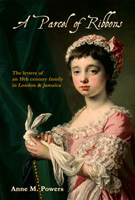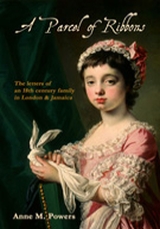“Bella” Holmes, photographed in 1895 (courtesy of Jake Holmes)
But for the efforts of the wonderful Mrs Basil Holmes much of what we know about London graveyards and burial grounds would have been lost. Instead of which we now have not only the results of her labours in her book on The London Burial Grounds, but its descendants in modern websites such as Londonburials to aid in our search for lost ancestors. Many of those who went to Jamaica had London roots, and many who made their fortunes in Jamaica came ‘home’ to settle in and around the capital.
Isabella Matilda Gladstone was born in 1861, the sixth of seven children of John Hall Gladstone (FRS and a Scientific Chemist) and his first wife Jane Mary Tilt. Isabella’s mother, her eldest sister and her only brother died when she was three in an epidemic of scarlet fever and diphtheria. Her father’s second wife died in childbirth six years later, barely a year after their marriage. Margaret, the child of this marriage, would go on to become the wife of Ramsay Macdonald, Britain’s first Labour Prime Minister.
In 1887 Isabella married Basil Holmes who was Secretary to the Metropolitan Public Gardens Association (MPGA) which had been founded five years earlier. Between 1888 and 1896 Isabella had two daughters and two sons, with another son coming along in 1905. During the 1890s the family lived at 5 Freeland Road, Ealing in west London and were able to employ various nursemaids, a cook and a housemaid. The Freeland Road house was a solid brick-built Victorian villa, comfortably situated between Ealing Common and the Ealing Lawn Tennis Club, but the founders of the MPGA were only too well aware that many Londoners lived in squalid slums, seeing little sunlight, rarely seeing any greenery and with no safe places for their children to play.
It was the dawning age of metropolitan socialism that brought about the clearing of slums, the building of ‘model dwellings’ and the first social housing, and the erection of public baths, lavatories and wash-houses for those with no proper sanitation or running water at home.
Before she married Basil Holmes, Isabella had already been providing information to the MPGA. Looking at one of the classic eighteenth century maps of London, by John Rocque, she had noticed that many burial grounds and churchyards marked on it no longer existed. Intrigued, she investigated what had happened to them and drew up a list which was published in the first MPGA report in 1884.
There was a serious lack of good information. From the mid-nineteenth century many burial grounds were so overcrowded as to become a serious health hazard, the ground level having risen several feet as coffin was piled upon coffin. Many were closed for new burials, and as congregations moved out of the City to the suburbs church attendances fell and churches were closed and demolished, replaced by commercial developments.
In 1884 the Disused Burial Grounds Act was passed with the aim of preventing unregulated development on graveyards. One consequence of this however was that builders finding bones would hush up the discovery and hastily cart away the evidence for disposal elsewhere. Isabella mentions that even in poor Whitechapel building land was worth £30,000 an acre, putting every unrecorded and forgotten burial ground in danger of development.
This then was the context in which she began her work, a task that lasted more than a dozen years, from the early days of the MPGA through marriage, a family, and finally the production of her book in 1896 which accompanied a set of colour-coded maps that she presented to the London County Council. The maps comprised 60 Ordnance Survey 25-inches to the mile sheets, with burial places still in use coloured blue, those that were disused coloured green and those now converted for public recreation coloured red. In the County and City of London she had documented 362 burial grounds, of which 41 were still in use and 90 had become public gardens or playgrounds for slum children. She did not include in this number churches and chapels which had burial vaults but no graveyard. She did however extend her searches to include non-conformist, Quaker and Jewish burial places.
Early on in her work Bella realised that there was no substitute for seeing things on the ground, and off she went notebook in hand searching for burial grounds that she knew should still be there, but which now were often back yards filled with rubbish. Often access was difficult, but a letter of introduction got her into a Jewish cemetery from which her Christian status would otherwise have excluded her. And she was not above climbing fences to peer beyond – ‘One day I climbed a high rickety fence in a builder’s yard in Wandsworth in order to see over the wall into the Friends’ burial-ground. No doubt the men in the place thought me mad, – anyhow they left me in peace.’
She would knock on doors and ask to look out of people’s rear windows to locate old graveyards. Moreover, intrepid but careful, she was quite happy to venture into parts of London she was told were unsafe. ‘An appearance of utter insignificance and an air of knowing where you are going and what you want, is the passport for all parts of London’. One feels she would have made a good spy!
Having collected a wealth of books and information during her searches, Isabella’s own book includes much useful background information on the development of London, albeit some of her archaeological comments have been superseded by more recent work. The book covers British and Roman burying-places; the graveyards of priories and convents; the Cathedral, the Abbey, the Temple and the Tower; the City churchyards; London churchyards outside the City; pest-fields and plague-pits; the dissenters’ burial-grounds; burial places of foreigners in London; hospital, almshouse and workhouse grounds; private and promiscuous cemeteries; the closing of burial grounds and vaults; graveyards as public gardens; cemeteries still in use and a ‘forecast for the future’.
In this last chapter she showed herself somewhat ahead of the times in discussing cremation of the dead, which would help to reduce the need for additional burial places. Not until after the First World War, when so many of the dead had no known resting place, would cremation become as accepted as burial.
The book also has an appendix with extensive listings of extant and disappeared burial grounds, and instructions on how to lay out a burial-ground as a garden. There are also many illustrations of churches and graveyards and contemporary photographs.
It all makes fascinating reading, and moreover her book is still in use by professional archaeologists in London. It is fascinating to compare Isabella’s descriptions of St Pancras after the arrival of the Midland railway, with the Museum of London Archaeology book on the St Pancras Burial Ground, published last year, following the redevelopments for St Pancras International station.
You will be hard put to find a copy of Isabella’s original book for sale, and if you do it will not be cheap, but thanks to print-on-demand technology you can easily obtain a reprint from the British Library Historical collection.
It is well worth the read.












